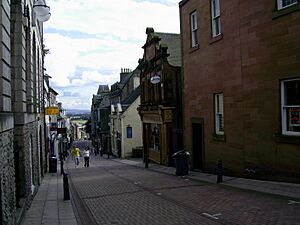History of Dunfermline facts for kids
Dunfermline is a city in Fife, Scotland. It used to be a special town called a "burgh." The city grew a lot because of Queen Margaret, becoming an important religious center. On May 20, 2022, Dunfermline officially became a city.
Contents
Early History of Dunfermline
The name "Dunfermline" comes from old words. "Dun" means a fortified hill, "fiaram" means bent or crooked, and "lin" means a waterfall or pool. This name likely describes the area around a tower hill where a small river bends and drops over a waterfall.
One of the first records of Dunfermline shows it was a religious center for the Culdees around 570 AD. The written history of the city really begins with King Malcolm III in the mid-11th century. He moved the main seat of power from Perthshire to Dunfermline, making it the capital of Scotland.
King Malcolm III married Queen Margaret in 1069. She was a very religious person. Margaret encouraged King Malcolm to change the small Culdee church into a Benedictine priory. This new church opened around 1072. Queen Margaret brought many religious items, including a special crucifix made of ebony, gold, and silver.
King Malcolm III died in battle in 1093. Queen Margaret died shortly after, on November 10, 1093, at Edinburgh Castle. Her body was brought to Dunfermline for burial. This journey was difficult because the castle was under attack at the time.
Dunfermline Abbey: A Powerful Place
The Benedictine priory became a full abbey in 1128, thanks to King David I. Over many years, the abbey became very rich and powerful in Dunfermline. People and groups gave many gifts to the abbey, including 26 altars. The Bishop of Dunfermline controlled a large area of land across Scotland.
In 1291, the abbey was allowed to dig for coal in the lands of Pittencrieff. This is one of the oldest records of coal mining in Scotland. It helped many people in West Fife find work.
The abbey was built and changed over many years, between 1128 and 1450. Different parts were added, like a nave and a choir. Robert the Bruce, a famous Scottish king, helped with some restoration work before he died and was buried there in 1329.
However, the abbey also faced tough times. In 1303, the troops of Edward I caused a lot of damage. Later, during the Reformation in 1560, some parts of the abbey were destroyed. This included the shrine of St Margaret, which was a very important religious site.
Dunfermline's Royal Status and Gates
The town's name was first written as "Dunfermelitane" in 1128. The name "Dunfermline" was officially adopted in 1609. Dunfermline became a "burgh of barony" between 1124 and 1147. Later, King James VI gave it "Royal Burgh" status in 1588.
In 1396, six gates were built around Dunfermline. These gates helped control who entered and left the town. They also helped collect tolls (money) and offered some defense. Some of these gates included the Mill Port, Rottenraw Port, and Crosswynd Port.
Dunfermline was the capital of Scotland until 1437. After King James I was killed in Perth, the royal family felt safer in Edinburgh Castle. Towns like Dunfermline and Stirling could not offer enough protection from powerful nobles.
From Royal Decline to Linen Power
In 1603, the Scottish and English crowns united, and the Scottish courts moved to London. This meant Dunfermline lost its strong royal connections. A big fire in 1624 destroyed much of the city. After the Reformation, Dunfermline also lost its status as a major religious center. The city quickly started to decline.
However, in the 18th century, Dunfermline began to recover. In 1718, James Blake started weaving linen damask. This was a special technique he learned in Edinburgh. Dunfermline soon became known as the world's leading producer of linen damask. By 1810, it was one of the main centers for this industry in Scotland.
The introduction of power looms by 1825 further boosted the linen industry. Dunfermline embraced the Industrial Revolution. The quality of Dunfermline's damask was famous, with one report in 1894 saying it was "unequalled in the world." Other industries also grew in the town, including dyeing, bleaching, soap making, and rope making.



